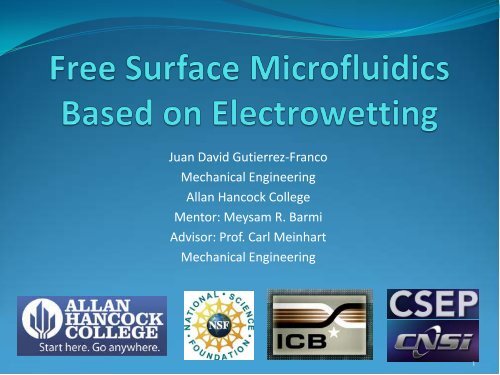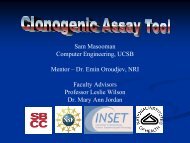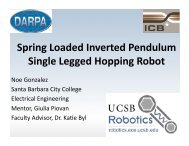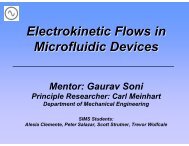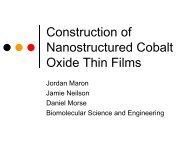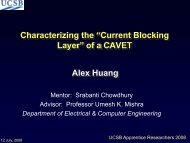Download Final Presentation
Download Final Presentation
Download Final Presentation
Create successful ePaper yourself
Turn your PDF publications into a flip-book with our unique Google optimized e-Paper software.
Juan David Gutierrez-Franco<br />
Mechanical Engineering<br />
Allan Hancock College<br />
Mentor: Meysam R. Barmi<br />
Advisor: Prof. Carl Meinhart<br />
Mechanical Engineering<br />
1
Why is microfluidics<br />
important<br />
• Reduction of laboratory size, analysis<br />
time, and sample needed<br />
• Micro Total Analysis System (μTAS)<br />
• Lab-on-a-Chip (LOC)<br />
• Microarrays<br />
• Portable and easily controllable<br />
devices for chemical and biological<br />
applications<br />
Lab-on-a-Chip (LOC)<br />
http://gigaomized-greendemo.blogspot.com/2011/02/lab-onchip-what-is-this.html<br />
2cm<br />
10cm<br />
Microarray<br />
http://i.i.com.com/cnwk.1d/i/ne/p/2<br />
007/fluidigm-007_550x367.jpg 2
The Big Picture<br />
• Mixing chemicals to perform<br />
experiments<br />
Evaporation of solvent<br />
Mixing<br />
Evaporation<br />
3
Goals of the Project<br />
Closed System<br />
• To understand the physics of<br />
electrowetting on open and<br />
closed systems<br />
• To create and test open<br />
surface electrowetting<br />
devices<br />
Open System<br />
• To lower required voltage to<br />
move droplet<br />
• To control the evaporation<br />
rate of the droplet<br />
Evaporation<br />
4
Lab-on-a-Chip mixing chemicals<br />
2.5 mm<br />
Lab-on-a-Chip performing chemical reactions<br />
http://www.chem.utoronto.ca/staff/WHEELER/html/Main.htm<br />
5
Electrowetting<br />
Droplets containing different chemicals need to be<br />
mixed. The movement is done with electrowetting.<br />
6
Research Method: Electrowetting<br />
• Apply voltage to<br />
droplets on chips to<br />
achieve<br />
electrowetting<br />
without electrolysis.<br />
• Try different solution<br />
concentrations,<br />
dielectrics, voltages<br />
and frequencies.<br />
1.5 cm<br />
2.5 cm<br />
7
Research Method: Electrowetting<br />
1M KCl solution 4V 1kHz gold electrode<br />
8
Research Method: Electrowetting<br />
65.0<br />
Contact Angle Change vs. Voltage<br />
f=100 Hz 2.0 M KCl<br />
55.0<br />
Contact Angle Change (°)<br />
45.0<br />
35.0<br />
25.0<br />
15.0<br />
5.0<br />
Electrowetting<br />
Electrolysis<br />
Saturation<br />
-5.0 0.0 1.0 2.0 3.0 4.0 5.0 6.0<br />
Voltage (V)<br />
Saturation is seen once the contact angle does not<br />
change while increasing voltage.<br />
9
Higher molarity solutions show<br />
better response to voltage at 1 kHz<br />
Concentration Electrowetting Electrolysis<br />
1 M KCl 4 V 6 V<br />
0.1 M KCl 24 V 16 V<br />
0.01 M KCl 120 V 90 V<br />
• 1 M KCl solution showed the lower voltage needed to cause<br />
electrowetting.<br />
• As molarity dropped, electrolysis occurred sooner than<br />
electrowetting.<br />
10
Effect of Molarity on<br />
Electrowetting and Electrolysis<br />
Molarity<br />
2.00<br />
1.75<br />
1.50<br />
1.25<br />
1.00<br />
0.75<br />
0.50<br />
0.25<br />
0.00<br />
Molarity vs. Voltage 300 Hz<br />
Electrowetting<br />
Electrolysis<br />
0.0 5.0 10.0<br />
Voltage (V)<br />
KCl solution on gold electrode with no dielectric.<br />
Molarity<br />
2.00<br />
1.75<br />
1.50<br />
1.25<br />
1.00<br />
0.75<br />
0.50<br />
0.25<br />
0.00<br />
Molarity vs. Voltage 1 kHz<br />
Electrowetting<br />
Electrolysis<br />
0.0 5.0 10.0 15.0<br />
Voltage (V)<br />
• As molarity and frequency drop, electrolysis occurs<br />
sooner.<br />
11
Molarity Effect on Contact Angle<br />
Change<br />
Contact Angle Change ( )<br />
Contact Angle Change vs. Voltage<br />
f=300 Hz<br />
60.0<br />
50.0<br />
40.0<br />
0.1 M<br />
30.0<br />
0.5 M<br />
20.0<br />
1.0 M<br />
10.0<br />
2.0 M<br />
0.0<br />
0.0 2.0 4.0 6.0 8.0 10.0 12.0<br />
Voltage (V)<br />
Contact Angle Change ( )<br />
60.0<br />
50.0<br />
40.0<br />
30.0<br />
20.0<br />
10.0<br />
Contact Angle Change vs. Voltage<br />
f=1000 Hz<br />
0.1 M<br />
0.5 M<br />
1.0 M<br />
2.0 M<br />
0.0<br />
0.0 2.0 4.0 6.0 8.0 10.0 12.0<br />
Voltage (V)<br />
• Actuation voltage is same for all cases.<br />
• Saturation is reached sooner by the higher molarity<br />
solutions.<br />
12
Evaporation<br />
Once the droplets are mixed, the solvent needs to be<br />
evaporated.<br />
13
Research Method: Evaporation<br />
• Made of two<br />
layers: Ti/Pt<br />
(200/2500Å)<br />
• Resistance is<br />
measured<br />
Resistive Temperature Detector (RTD)<br />
• Resistance relates<br />
linearly to<br />
temperature<br />
14
Calibration of RTD<br />
• Fabrication can alter properties of<br />
the RTD<br />
• Calibration is needed for each chip<br />
• Readings of resistance at known<br />
temperature used for calibration of<br />
RTD.<br />
Resistance (Ω)<br />
Calibration RTD Sample 1<br />
41.5<br />
41.0<br />
40.5<br />
40.0<br />
39.5<br />
39.0<br />
38.5<br />
296.0 301.0 306.0 311.0<br />
Temperature (K)<br />
Resistivity (nΩ*m)<br />
160.0<br />
155.0<br />
150.0<br />
145.0<br />
R = 0.1532T - 6.6023 140.0<br />
Average Resistivity RTD<br />
295.0 300.0 305.0 310.0 315.0<br />
Temperature (K)<br />
15
Evaporation Time<br />
• Evaporation rate was measured and plotted vs. temperature<br />
Evaporation Rate (nL/s)<br />
5.0<br />
4.0<br />
3.0<br />
2.0<br />
1.0<br />
Evaporation Rate vs Temperature<br />
0.0<br />
305.0 310.0 315.0 320.0 325.0 330.0<br />
Temperature (K)<br />
• As temperature increases, the rate of evaporation of droplets<br />
increases.<br />
16
Summary<br />
•<br />
17
Future Plans<br />
• Find dielectric that decreases voltage needed for<br />
electrowetting and prevents electrolysis.<br />
• Find way to dewet a droplet after electrowetting occurs.<br />
• Control the evaporation rate of the droplet using a peltier<br />
heater and the reading of the resistance of the RTD.<br />
• Combination of electrowetting and evaporation devices.<br />
18
Acknowledgments<br />
• INSET Program organizers<br />
• Jens-Uwe Kuhn<br />
• Dr. Nick Arnold<br />
• Prof. Megan Valentine<br />
• Arica Lubin<br />
• Microfluidics Lab<br />
• Prof. Carl Meinhart<br />
• Meysam R. Barmi<br />
• Irvin Martinez<br />
19
Thank you for your<br />
attention<br />
Summer 2011<br />
20
Definitions<br />
• Electrowetting: modification of the properties of the droplet’s<br />
surface by applying electricity.<br />
• Modifies contact angle and surface tension.<br />
• Surface from hydrophobic to hydrophilic<br />
• Microfluidics: use of small volumes of fluid to perform tasks<br />
(reactions, movement, mixing)<br />
• Free Surface: system where the droplet is in contact with the air.<br />
• Hydrophobic: repels water<br />
• Hydrophilic: attracts water<br />
22
Contact Angle<br />
• Distance at which the<br />
liquid (droplet) and<br />
vapor (air) interface<br />
meets a solid surface.<br />
• If the angle is:<br />
• >90 surface is<br />
hydrophilic<br />
•
Electrolysis<br />
• KCl is present in solution as<br />
ions<br />
• Once voltage is applied,<br />
positive ions (K+) go to the<br />
negative electrode and<br />
negative ions (Cl-) go to the<br />
positive electrode<br />
• K gains an electron<br />
• Forms potassium atoms<br />
• Cl loses an electron<br />
• Forms chlorine atoms<br />
24
Electrolysis happening<br />
25
Residue seen on chips<br />
Desired residue<br />
after electrowetting<br />
Residue when<br />
electrolysis occurs<br />
(7V)<br />
Residue when<br />
electrolysis occurs<br />
(100V)<br />
26
Electrowetting Effect<br />
Before<br />
After<br />
27
Before<br />
After<br />
28
Change in diameter of droplet after<br />
electrowetting<br />
~4mm<br />
~5mm<br />
Before<br />
After<br />
29
RTD Cross-Section<br />
• Two layers<br />
• 200 Å Titanium<br />
• Acts as adhesive<br />
• 2500 Å Platinum<br />
30
Peltier Cooler<br />
• Used to cool or heat chips.<br />
• Positive voltage on red cable<br />
cools the top surface and heats<br />
the bottom surface<br />
• Negative voltage on red cable<br />
heats the top surface and cools<br />
the bottom surface<br />
31
Evaporation Rate Curve<br />
•<br />
32


